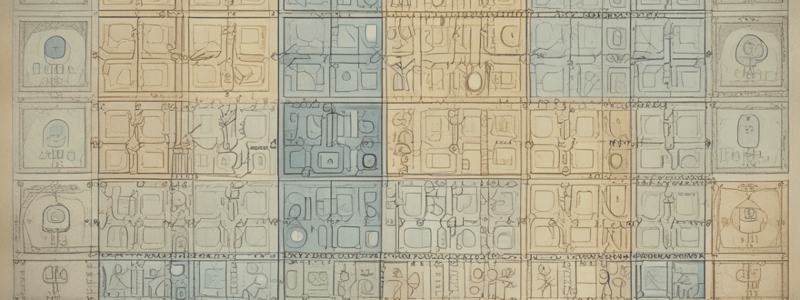Podcast
Questions and Answers
What is a Punnett square used for?
What is a Punnett square used for?
To calculate the expected proportions of genotypes and phenotypes in a genetic cross.
What is the genotypic ratio in a dihybrid cross?
What is the genotypic ratio in a dihybrid cross?
9:3:3:1
Who is the Punnett square named after?
Who is the Punnett square named after?
Reginald Punnett.
Explain why the genotypic ratios in a dihybrid inheritance are 9:3:3:1.
Explain why the genotypic ratios in a dihybrid inheritance are 9:3:3:1.
What do genotypic ratios refer to?
What do genotypic ratios refer to?
What is the phenotypic ratio in a monohybrid cross?
What is the phenotypic ratio in a monohybrid cross?
In a monohybrid cross, what are the expected offspring ratios for dominant (purple) and recessive (white) phenotypes?
In a monohybrid cross, what are the expected offspring ratios for dominant (purple) and recessive (white) phenotypes?
Who is Gregor Mendel and why is Mendelian genetics named after him?
Who is Gregor Mendel and why is Mendelian genetics named after him?
What is the phenotypic ratio for a monohybrid cross involving a dominant purple phenotype and a recessive white phenotype?
What is the phenotypic ratio for a monohybrid cross involving a dominant purple phenotype and a recessive white phenotype?
What is dihybrid inheritance?
What is dihybrid inheritance?
How does a Punnett square help in predicting the genotypic outcomes of a genetic cross?
How does a Punnett square help in predicting the genotypic outcomes of a genetic cross?
What does a genotypic ratio of 1:2:1 indicate in a monohybrid cross?
What does a genotypic ratio of 1:2:1 indicate in a monohybrid cross?
What is monohybrid inheritance focused on?
What is monohybrid inheritance focused on?
What do phenotypic ratios describe?
What do phenotypic ratios describe?
Explain why the genotypic ratio in a monohybrid cross is 1:2:1.
Explain why the genotypic ratio in a monohybrid cross is 1:2:1.
What important concept in genetics does the phenotypic ratio highlight?
What important concept in genetics does the phenotypic ratio highlight?
In a dihybrid cross between two heterozygous individuals for both traits, what are the expected genotypic and phenotypic ratios?
In a dihybrid cross between two heterozygous individuals for both traits, what are the expected genotypic and phenotypic ratios?
Explain how codominance differs from incomplete dominance in terms of heterozygous phenotypes.
Explain how codominance differs from incomplete dominance in terms of heterozygous phenotypes.
How does X-linked inheritance differ from autosomal inheritance in terms of gene location?
How does X-linked inheritance differ from autosomal inheritance in terms of gene location?
In a monohybrid cross between two heterozygous individuals, what are the chances of obtaining a homozygous dominant offspring?
In a monohybrid cross between two heterozygous individuals, what are the chances of obtaining a homozygous dominant offspring?
Explain why linked genes do not follow the Mendelian principle of independent assortment.
Explain why linked genes do not follow the Mendelian principle of independent assortment.
Flashcards are hidden until you start studying
Study Notes
Mendelian genetics is a branch of genetics that focuses on the principles of inheritance. This topic is named after Gregor Mendel, who is known for his work on pea plants and his laws of inheritance. Mendelian genetics is concerned with the transmission of genetic traits from parents to their offspring. In this article, we will discuss Punnett squares, genotypic ratios, dihybrid inheritance, monohybrid inheritance, and phenotypic ratios, which are all subtopics within Mendelian genetics.
Punnett Squares
A Punnett square is a tool used to calculate the expected proportions of genotypes and phenotypes in a genetic cross. It is named after Reginald Punnett, a British geneticist who devised this approach. A Punnett square consists of a matrix in which all possible gametes produced by one parent are listed along one axis, and the gametes from the other parent are listed along the other axis. Each possible combination of gametes is listed at the intersection of each row and column. The F1 cross would be drawn as in Figure 1.5.1.
Genotypic Ratios
Genotypic ratios refer to the ratio of different genotypes in the offspring from a genetic cross. In a monohybrid cross, the offspring ratios will be 3:1 of dominant phenotype (purple): recessive phenotype (white). For example, if we perform a cross between two true-breeding parents for a single trait, such as yellow versus green seeds, the genotypic ratio will be 1:2:1, representing the different combinations of dominant and recessive alleles in the offspring.
Dihybrid Inheritance
Dihybrid inheritance refers to the inheritance of two traits at the same time. In a dihybrid cross, the genotypic ratios are 9:3:3:1, with three dominant, three heterozygous, and one recessive phenotype. This is because each parent contributes one allele for each trait, and the alleles segregate independently.
Monohybrid Inheritance
Monohybrid inheritance is the inheritance of a single trait. In a monohybrid cross, the genotypic ratio is 1:2:1, and the phenotypic ratio is 3:1 for dominant to recessive phenotypes.
Phenotypic Ratios
Phenotypic ratios refer to the ratio of different phenotypes in the offspring from a genetic cross. In a monohybrid cross, the phenotypic ratio is 3:1 of dominant phenotype (purple): recessive phenotype (white).
In conclusion, Mendelian genetics is a fascinating field that provides insights into the transmission of genetic traits from parents to their offspring. Punnett squares, genotypic ratios, dihybrid inheritance, monohybrid inheritance, and phenotypic ratios are all important subtopics within this field, helping us understand the principles of inheritance.
Studying That Suits You
Use AI to generate personalized quizzes and flashcards to suit your learning preferences.




